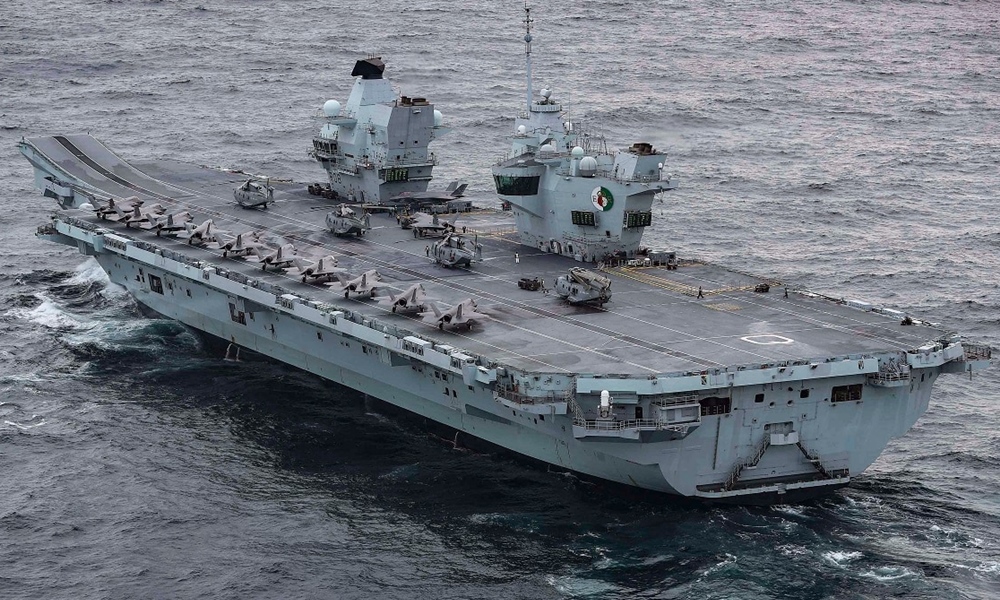HMS Queen Elizabeth R08 – The Pinnacle of Modern UK Aircraft Carriers
Building on the ambitious vision of reclaiming its naval prominence, Britain embarked on the construction of the new generation Queen Elizabeth-class aircraft carriers. Leading this formidable carrier class is the HMS Queen Elizabeth, a monumental achievement in naval engineering and the largest warship ever constructed for the Royal Navy of the United Kingdom. With the capacity to accommodate up to 60 aircraft, this vessel represents a remarkable leap forward in British naval capabilities.
Recent developments, however, have cast a shadow over the vessel’s operational readiness. As reported by British media, the HMS Queen Elizabeth encountered a serious mechanical malfunction that rendered it propulsion-less, prompting its return to Portsmouth. This incident follows closely on the heels of another concerning episode involving the bursting of a salt-water pipe that nearly caused the drowning of three servicemen aboard the ship.
Remarkably, despite these setbacks, the HMS Queen Elizabeth managed to make significant strides during its 23 days at sea, underscoring the dedication and capabilities of the Royal Navy. Yet, the scale of the mechanical issue necessitates a comprehensive repair effort, potentially incurring substantial costs. Despite the financial implications, the UK Ministry of Defense has expressed its commitment to restoring the ship to operational status as swiftly as possible.
The saga of the HMS Queen Elizabeth is reminiscent of its storied history. The ship’s journey began in July 2007 when the order for two carriers was placed. Originally anticipated to be operational by 2015, various challenges including the global financial crisis led to delays and extended the delivery timeline to 2020. Alongside these delays, the projected cost of the carrier project surged to a staggering £6.2 billion. This investment underscores the gravity of the vessel’s role in Britain’s maritime ambitions.
The design evolution of the HMS Queen Elizabeth is emblematic of its adaptability and innovation. Initially modeled after modern US carriers with catapult launch systems and arresting gear, the ship’s design was subsequently reshaped to accommodate the acquisition of the American Lockheed F-35B Lightning II Short Take-Off and Vertical-Landing stealth strike fighter. This strategic decision led to the incorporation of a “ski-type” ramp at the bow, streamlining the launch process for the fighter aircraft.
Functionally, the HMS Queen Elizabeth boasts an island superstructure on its starboard side, serving as the nerve center for flight activities and ship operations. The flight deck is supported by hangar elevators strategically positioned to minimize congestion. This expansive flight deck facilitates a range of operations, including at-sea resupply, special forces support, and specialized missions conducted by the latest British helicopters.
Distinguishing itself from its American counterparts, the HMS Queen Elizabeth operates through conventional integrated electric propulsion rather than nuclear power. Its propulsive power is derived from an array of advanced engines, including Rolls-Royce Marine Trent MT30 gas turbine generators and various diesel generators, resulting in a top speed of approximately 25 knots.
In terms of its operational capacity, the HMS Queen Elizabeth can accommodate up to 36 F-35B aircraft and four Crowsnest airborne early warning helicopters. Alternatively, it can be configured to house helicopters and gunships for various strategic roles. Despite its impressive dimensions – approximately 920 feet in length and a flight deck width of 280 feet – the ship maintains a level of flexibility for growth as future upgrades are integrated.
Defensively, the HMS Queen Elizabeth is equipped with sophisticated systems designed to counter airborne threats. Its defense array comprises 20mm Phalanx Close-In Weapons Systems, 30mm Automated Small Caliber Guns, and Miniguns for rapid response to fast attack craft. For high-risk situations, the Type 45 destroyer often accompanies the vessel, further enhancing its protection.
In sum, the HMS Queen Elizabeth stands as a testament to Britain’s commitment to maritime security and global influence. Beyond its physical dimensions, it embodies the nation’s dedication to preserving its status as a formidable naval power, projecting reassurance to allies while deterring potential adversaries. The journey of the HMS Queen Elizabeth underscores the complexities and challenges of modern naval engineering, highlighting the United Kingdom’s steadfast resolve to navigate these challenges and stand at the forefront of maritime capabilities.
Hits: 30












